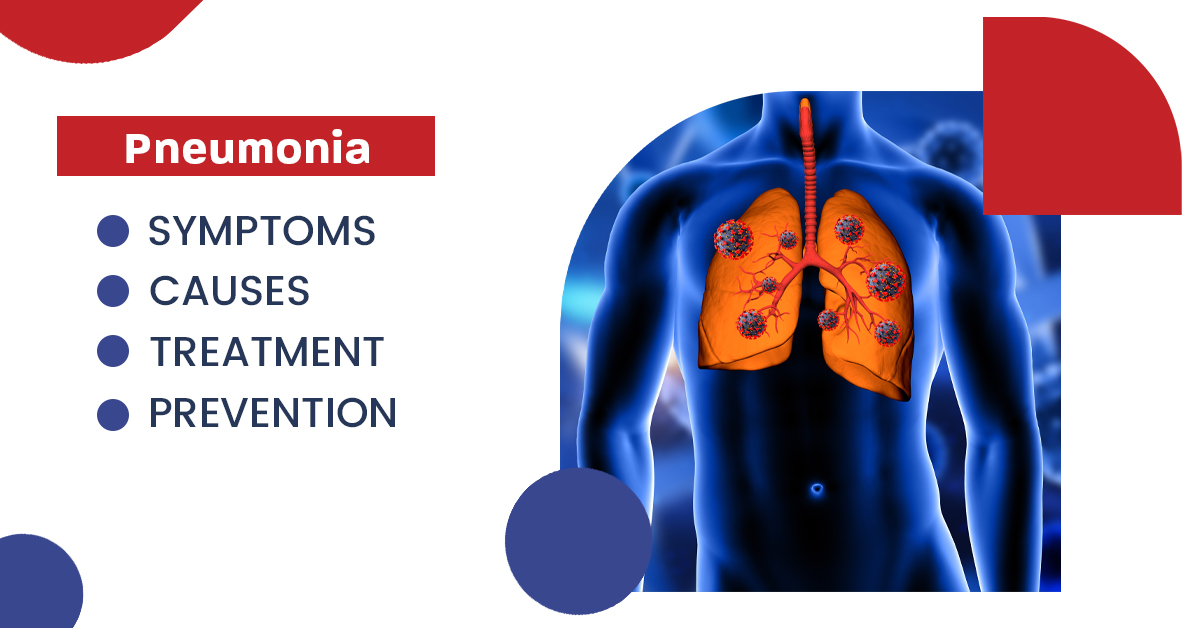An individual with pneumonia experiences inflammation in the air sacs of one or both lungs. Fluids and pus (purulent material) may fill the air sacs, leading to breathing difficulties, fever, chills, and a cough that produces pus or phlegm. In addition to bacteria, viruses, and fungi, pneumonia can be caused by several different species.
Types of Pneumonia:
Depending on the etiology, many forms of pneumonia exist. The many types and the underlying reasons for them include.
- Bacterial pneumonia: Pneumonia can be caused by a variety of bacterial types, however, the most typical is Streptococcus pneumoniae (S. pneumoniae). This strain of pneumonia may be referred to as pneumococcal pneumonia by a physician.
- Viral pneumonia: The respiratory syncytial virus and influenza types A and B are viral causes of pneumonia.
- Fungal pneumonia: This could be the outcome of an illness like valley fever, which is brought on by the fungus Coccidioides.
- Aspiration pneumonia: This kind of happens when food, drinks, or stomach contents are inhaled into the lungs. Pneumonia from aspiration is not communicable.
- Hospital-acquired pneumonia: This can happen to patients receiving hospital care for ailments that necessitate the use of a respirator or breathing apparatus.
Symptoms of Pneumonia:
Pneumonia symptoms can be as subtle as you hardly notice them or as severe as you need to be hospitalized. Depending on the type of germ causing the infection, your age, and your general health, your body will react to pneumonia in different ways.
Pneumonia can show a variety of symptoms, including
- Fever, sweating, and chills that shake.
- respiration difficulty.
- shallow, quick breathing
- Chest pain that is piercing or stabbing and that worsens when you cough or breath deeply.
- poor energy, weariness, and loss of appetite.
- vomiting and nausea, especially in young children.
- confusion, particularly among the elderly.
Causes of Pneumonia:
Pneumonia can be brought on by numerous bacteria. The air we breathe is primarily filled with bacteria and viruses. Normally, your bodyguards are against dangerous microorganisms entering your lungs. However, even if your health is generally good, these viruses have the power to occasionally overwhelm your immune system.
There are various types of pneumonia, depending on the pathogens that infect you and how you got the infection.
- Community-acquired pneumonia
As the most common form of pneumonia, community-acquired pneumonia is a contagious illness. It takes place apart from hospitals or other medical institutions. Possible causes include
-
- Streptococcus pneumonia is the most typical bacterial pneumonia culprit in the United States. This particular form of pneumonia may appear on its own or after a cold or the flu. One lobe of the lung can only be impacted by lobar pneumonia.
- Bacteria-like organisms. Pneumonia can also be brought on by Mycoplasma pneumonia. There are usually fewer severe symptoms associated with this kind of pneumonia compared to other forms. This type of pneumonia is sometimes referred to as “walking pneumonia” since it frequently does not necessitate bed rest.
- This type of pneumonia is more common in people with weakened immune systems, chronic health issues, and people who have inhaled significant levels of the germs. The fungus that produces it might be discovered in bird droppings or soil, depending on the locale.
- virus strains, such as COVID-19. Several viruses that cause colds and the flu can also cause pneumonia. Children under the age of five are most likely to contract pneumonia from viruses. Typical viral pneumonia is not dangerous. It can, however, occasionally become very serious. The 2019 coronavirus (COVID-19) pneumonia may become a serious condition.
- Hospital-acquired pneumonia
Some individuals who are being treated for another illness while in the hospital also acquire pneumonia. Hospital-acquired pneumonia can be serious because the people who get it are already unwell and because the bacteria that causes it may be more resistant to medications. Patients who use ventilators, which are widespread in intensive care units, are more likely to develop this type of pneumonia.
-
Healthcare-acquired pneumonia
Patients receiving treatment at outpatient clinics, such as kidney dialysis centers, or who dwell in long-term care homes, may contract a bacterial illness known as “healthcare-acquired pneumonia.” Healthcare-acquired pneumonia is more likely to be caused by antibiotic-resistant bacteria than hospital-acquired pneumonia.
- Aspiration pneumonia
Aspiration pneumonia occurs when you breathe in food, liquids, vomit, or saliva into your lungs. Aspiration is more likely to happen if something inhibits your normal gag reflex, such as brain damage, swallowing difficulties, or heavy alcohol or drug use.
Complications:
Some pneumonia patients, particularly those in high-risk groups, may still develop problems while receiving treatment.
-
- Viruses and bacteria in the blood (bacteremia). Your lungs can transmit bacteria to other organs and cause organ failure if they are infected by the bacteria in your bloodstream.
- trouble breathing You can find it difficult to breathe in enough oxygen if your pneumonia is severe or if you have underlying chronic lung conditions. You might have to stay in the hospital and use a ventilator while your lung heals.
- buildup of fluid around the lungs (pleural effusion). In pneumonia, fluid can accumulate between the lungs and chest cavity as a result of the narrow spaces between layers of tissue (pleura). If the fluid becomes infected, you might need to have it medically or through a chest tube removed.
- lung infection. The formation of an abscess is caused by pus accumulating in the lung cavity. An abscess is usually treated with antibiotics. An abscess may require drainage through surgery or with the assistance of a long needle or tube.
Risk Factors of Pneumonia:
Anyone can have pneumonia, but some individuals are more susceptible than others. These groups consist of
- infants up to the age of two.
- folks who are over 65.
- people whose immune systems have been compromised by pregnancy, HIV, and/or the use of specific pharmaceuticals, such as steroids or specific cancer treatments.
- those who have certain long-term medical issues, like.
- asthma
- cystic fibrosis
- diabetes
- COPD
- heart failure
- sickle cell disease
- liver disease
- kidney disease
- especially if they were or are on a ventilator, those who have recently or are now hospitalized.
- those who have experienced a brain problem, such as a stroke, head injury, dementia, or Parkinson’s disease, which might impair the ability to swallow or cough.
Diagnosis of Pneumonia:
A doctor would often inquire about a patient’s symptoms, and medical background, and conduct a physical examination to determine whether they have pneumonia. A pulse oximeter affixed to the finger may be used to measure blood oxygen levels and listen to the chest during the physical examination.
When using a stethoscope to listen to the chest, a clinician may think the patient has pneumonia if they hear any of the following:
- coarse breathing
- wheezing
- crackling
- decreased breath sounds
Doctors may request extra testing, such as, if they suspect pneumonia.
- Chest X-rays. These can identify the afflicted lung regions and confirm the diagnosis of pneumonia.
- A CT scan of the chest can produce images of the lungs in greater detail.
- WBC count. A blood test that gauges the quantity of WBCs in the body. This aids in determining the severity of the infection and whether bacteria, viruses, or fungi are most likely to be to blame.
- A test for arterial blood gases. a blood test that can give a more precise readout of the body’s carbon dioxide and oxygen levels as well as other variables
- Blood samples. These could show whether the bacterial infection from the lungs has entered the bloodstream.
- Sputum analysis. Sputum is tested to identify the bacteria causing pneumonia.
- A procedure when a bronchoscope is inserted into the lungs while the patient is sedated.
The bronchoscope is a small, flexible tube with an attached light and camera that allows the doctor to see within the airways and lungs to evaluate diseased areas. When additional research is required, a doctor might advise this surgery.
Treatment of Pneumonia:
Pneumonia may typically be treated at home. However, hospitalization for therapy may be necessary for infants, children, and patients with severe pneumonia. Even when viral pneumonia is suspected, pneumonia is typically treated with antibiotics because there may also be a degree of bacterial infection. The degree and etiology of pneumonia will dictate the kind of antibiotic used and how it is administered.
Typical components of home-based care include.
- Antibiotics are administered orally as tablets or liquids.
- drugs that reduce pain.
- Use of paracetamol to lower fever.
- consuming lots of liquids, especially water, to aid in the lungs’ mucus-loosening process.
Typically, hospital-based treatment entails.
- intravenously administering antibiotics (via a drip into a vein).
- To make sure the body receives the oxygen it requires, uses oxygen treatment.
- Intravenous fluids can be given to a patient to treat dehydration or if they are too ill to eat or drink.
- Physiotherapy can help the lungs expel mucus.
Pneumonia of Prevention:
- Update your immunizations. All infants should start a series of vaccinations that guard against the bacterial form of pneumonia at two months old.
- All children over the age of 6 months should be vaccinated against the flu every year, regardless of whether they have an egg allergy.
- Teach kids to cover their mouths and noses when sneezing with a sleeve of their shirt or a facial tissue after using tissues, and discard them.
- Practice and teach proper hand washing.
- Toys, tables, and doorknobs should all be cleaned with soap and water or a disinfectant if they are often touched surfaces.
- Keep smoking out of the house.


